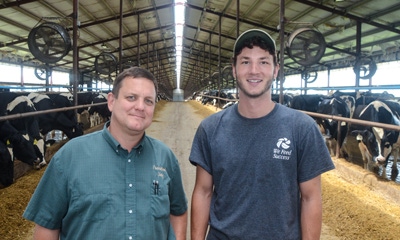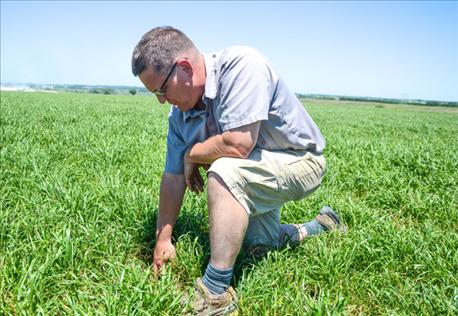
For father-and-son Dan and Ben Rice, who operate Prairie Land Dairy near Firth, cow health starts with soil health. "There's a direct correlation between healthier soil and quality of your milk," says Dan.
"You have to start with the soil. Everything starts with the soil. We know the quality of milk is directly affected by what we feed the cow, and the quality of what we feed the cow is affected by what we feed the soil," he notes.

MAKING MOST OF MANURE: For dairy producers like father-and-son Dan and Ben Rice, who operate Prairie Land Dairy near Firth, manure isn't just something to get rid of. It’s part of what Dan refers to as the three M's of what cows produce: meat, milk and manure. The goal is to use each to the best of its ability. In the case of Prairie Land, this means using manure in a way that benefits the soil. This includes applying gray water from the lagoon through the pivot on silage acres to add nitrogen and organic matter, and applying composted solid manure to build microbial activity.
This includes applying manure from the dairy onto silage acres. "One of our philosophies is cows produce meat, milk and manure — the three M's. We try to use all three to the best of our ability. Our goal is to use manure in a way that benefits the soil, and so we aren't just putting it out there to get rid of it," Dan says. "The problem we have in dairy manure is our phosphorus levels are a lot higher. We apply on a phosphorus basis, so we have to look for outside nitrogen sources."
Rice typically harvests corn at 60% to 70% moisture for silage, and applying manure directly from the lagoon in the form of gray water helps put organic matter back into the system. "We'll apply it through pivots and inject on some fields depending on what we need," says Dan. "We take a silage crop and then a second crop off. You're taking a lot of nutrients off, and you've got to replace them. It's much different than someone using a corn-soybean rotation."
Mixing up the rotation
Dan and Ben farm about 850 acres, but it takes 2,000 acres of silage to feed their 1,600 heifers and 1,600 cows. So, they contract with farmers to meet the rest of their silage needs, and apply manure and seed cover crops on those acres to add organic matter and keep the ground covered.

MICROBIAL BREAKDOWN: Ben Rice uses a compost windrow turner to turn a pile of compost to help aerate the pile for faster microbial decomposition. It typically takes two months for the compost to completely break down, and the pile has to be turned and aerated throughout the cycle. The right carbon-to-nitrogen ratio is needed to achieve the optimum microbial environment for Ben, who manages waste solutions at Prairie Land. He notes the ideal carbon to nitrogen ratio to create humus is about 30 to 1.
This year, they changed up their rotation from corn on corn to corn one year followed by Italian ryegrass the next. In addition, they have been cover-cropping for about 10 years. Planted in March, it's cut every 30 days, with five cuttings a year. From these total five cuttings, Dan says ryegrass typically yields 75% the amount of dry matter corn silage yields.
Their silage crop is followed by a cover crop mix seeded by Sept. 1, which will be harvested in October for feed. This usually includes a five-way mix of oats, cereal rye, mustard seed, rapeseed and radishes. "Oats are there as forage. Rye germinates in fall and sits there, but grows throughout the winter and gets the microbes going early," Dan says. Meanwhile, brassicas serve as a way to break compaction and improve infiltration. "We're doing deep tillage with radish and surface tillage with mustard and rapeseed. I can still find holes 2 feet down in the soil where the radishes died last fall."

NEW CROP IN ROTATION: Dan Rice digs into a stand of Italian ryegrass in June. This year, the Rices changed their rotation from corn on corn to corn one year followed by Italian ryegrass the next. Planted in March, the Italian ryegrass is cut every 30 days, with five cuttings a year. From these total five cuttings, ryegrass typically yields about 75% the amount of dry matter corn silage yields, Dan says.
Diversity seeps into every aspect of management at Prairie Land — including waste. Since 2000, the Rices have composted solids from manure, along with food waste to apply back on crop ground. "If you just had manure, you wouldn't have as good of compost," Dan says. "We bring in food waste from a number of sources. You've got to have the right carbon-to-nitrogen ratio, so we try to balance and monitor that."
Right balance for microbes
Ben, who manages waste solutions at Prairie Land, explains the ideal carbon-to-nitrogen ratio is about 30 to 1. "That's the most desirable ratio [to make] humus — the material that can support fungi, microbes, nematodes," he says. "Compost is breaking down, and humus is building back up."
It typically takes two months for the compost to completely break down, and the pile has to be turned, aerated and screened during the cycle to remove large solids. Before selling the compost, however, Ben usually lets it cure for six months to a year.
By itself, manure is in the low end of the carbon to nitrogen, with a high nitrogen content. So are food waste products like meat and vegetables. It takes a combination of these things, along with carbon sources like cornstalks used as bedding at the dairy, as well as tree trimmings, leaves and yard waste, to get the balance right.
As Ben explains, "If it's brown it's a carbon source. If it's green it's a nitrogen source."
Compost is applied back on the land using a manure spreader. With the right balance of carbon to nitrogen, the microbes have an ideal environment to thrive in the soil.
"When making compost, a lot of people have to add enzymes. I don't add enzymes, and I think it's because of the diversity of the microbe population. Putting it back on the land as composted organic matter with a diverse microbe population provides a good environment for those microbes to thrive," Ben says. "It's a system — it's not just cover crops or just compost. If you add microbes and they don't have the environment to thrive, they're not going to do anything."
About the Author(s)
You May Also Like






